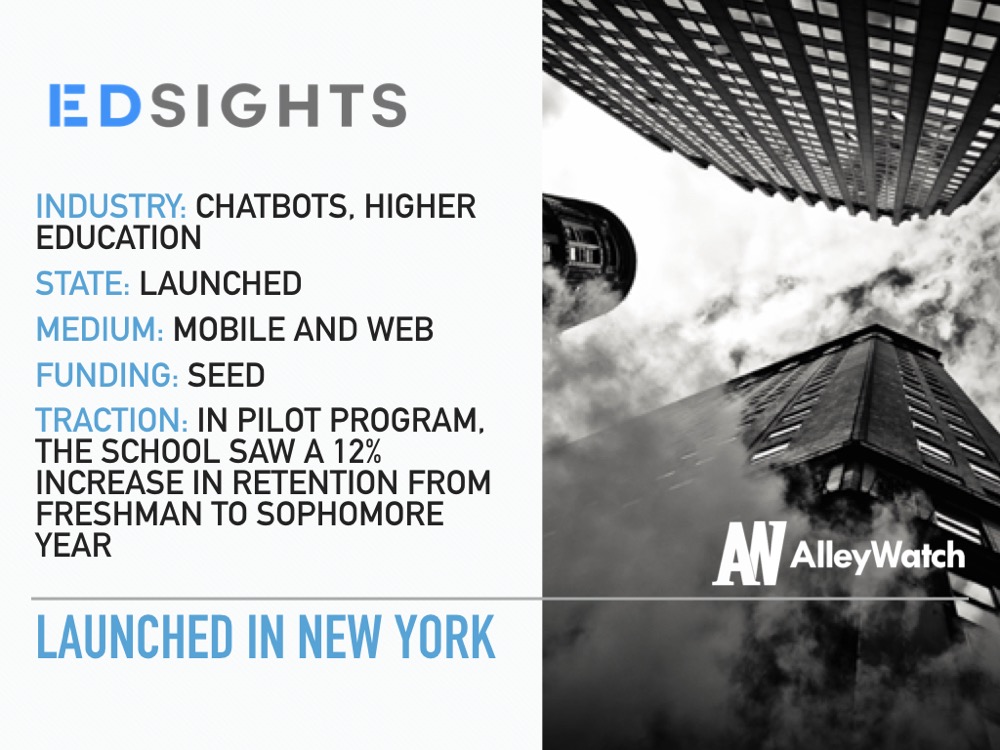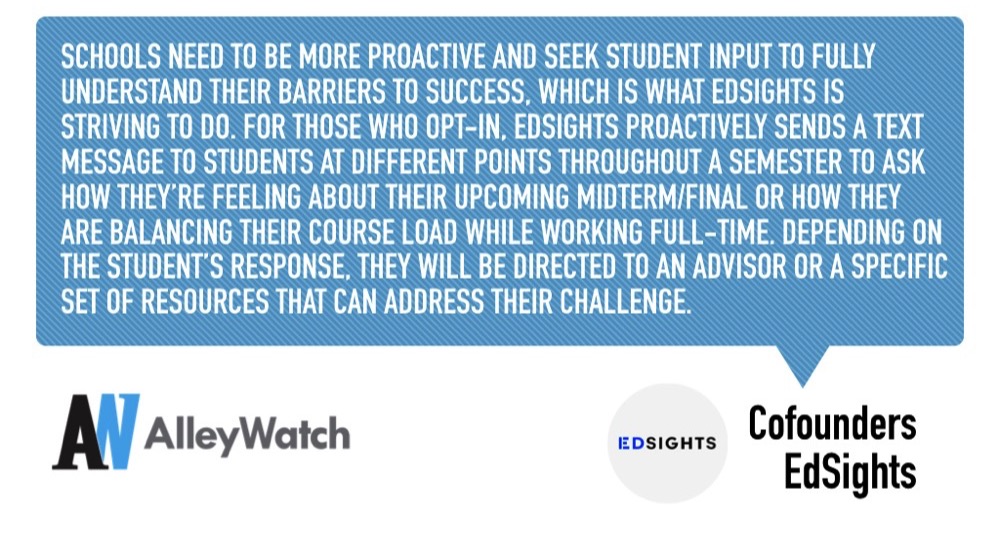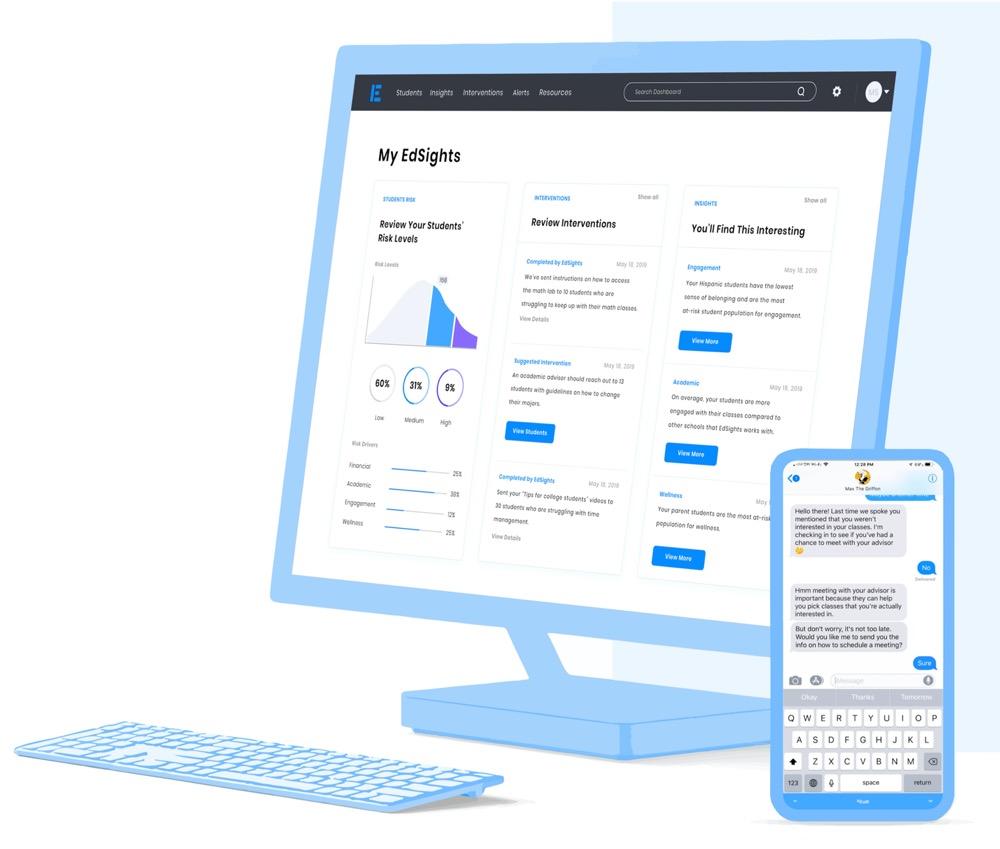Even though there are record numbers of people applying to colleges, retention rates are still an issue that every college faces, particularly public universities. According to an Educational Policy Institute study of 43 schools, there were only three public universities with graduation rates 90 percent and more of an entering class. EdSights is the machine learning-powered text messaging chatbot that colleges can deploy to understand why students are dropping out and, hopefully, prevent it by directing students to on-campus resources, as necessary. The conversational capabilities of the EdSights platform allows colleges to develop a better understanding of the primary causes and concerns that lead students to withdraw – whether its homesickness or difficulty balancing schoolwork while working a job. EdSights service costs ranges from $5 per student to $15 per student, compared to the figure that the average academic institution lost $9,910,811 as a result of students dropping out. EdSights affirms that it can increase retention by at least 7% and save institutions millions in tuition revenue.
AlleyWatch sat down with Cofounders Claudia Recchi and Carolina Recchi to learn more about the problem of retention at universities, the company’s inspiration, and future expansion plans.
Tell us about the product or service that EdSights offers.
EdSights is an SMS-based, machine learning (“ML”)-powered chatbot that gathers real-time insights into college students’ experiences to identify those that may be at-risk for dropping out. The chatbot, which supports over 100 languages, presents colleges and universities with data-backed solutions to improve opportunity for intervention, and in turn, student retention. EdSights uses natural language understanding to converse with students about their college experience and identify helpful on-campus resources if a struggle is detected. EdSights creates an open channel of communication with students to collect non-cognitive data in real-time and at scale, allowing institutions to uncover insights on areas that are hard to measure, such as a student’s sense of belonging or their at-home life, which oftentimes are the underlying catalysts for dropping out.
 What inspired the start of EdSights?
What inspired the start of EdSights?
We moved to the US from Italy to attend college and experienced firsthand the challenges of navigating the college transition, especially as foreign students. We saw where our respective universities fell short in providing us with the support we needed and realized there was a need for a service that tackled student retention from a different angle.
How is EdSights different?
Colleges across the U.S. are impacted by low retention rates, but their traditional method of relying on readily available data, such as grades and class attendance, to identify at-risk students is not effective. The issue is that these are no longer key indicators, just symptoms of a larger problem, and schools that use this data are failing students. This old way of identifying at-risk students leaves them entirely out of the conversation. Schools need to be more proactive and seek student input to fully understand their barriers to success, which is what EdSights is striving to do.
For those who opt-in, EdSights proactively sends a text message to students at different points throughout a semester to ask how they’re feeling about their upcoming midterm/final or how they are balancing their course load while working full-time. Depending on the student’s response, they will be directed to an advisor or a specific set of resources that can address their challenge.
EdSights presents colleges and universities an open channel of communication with students to collect non-cognitive data in real-time and at scale, giving them insights into areas that are often overlooked/not associated with academics and hard to measure when determining why a student is dropping out (like being homesick, having trouble balancing schoolwork while working a job, mental health, etc). Because EdSights provides a proactive solution that engages with students directly, we’re able to get to the core of the issues that students are facing early on and before any other retention solution, which dramatically increases the opportunity for intervention.
What market does EdSights target and how big is it?
EdSights targets the higher education market, which enrolls about 19 million students and employs about 3.4 million people, and was valued at $224.19 billion in 2018. It is expected to reach $526.83 billion by 2026.
But more specifically, we target student retention in the higher education space, which continues to cost higher education institutions millions. The Educational Policy Institute’s analysis of 1,669 colleges and universities found that they collectively lost revenue due to attrition in an amount close to $16.5 billion in a single academic year. The largest single school lost $102,533,338, while the average school lost $9,910,811.
What is the business model?
We sell to universities through B2B sales. We have an annual license and our price varies based on the size of the institution. Our price ranges from $5 per student to $15 per student. On average, when we enter an institution, we increase student retention by 7% and save institutions millions in tuition revenue, so our software more than pays for itself.
Who do you consider to be your primary competitors?
Competitors include other early alert systems that focus on academic performance (e.g. EAB) as well as other texting and chatbot providers that act more like 24/7 customer service for students.
What are the milestones that you plan to achieve within six months?
Widespread adoption of the EdSights platform by colleges and universities across the United States, and to make significant progress in solving the college dropout crisis.
What is the one piece of startup advice that you never got?
“Know what you don’t know. Ask for help and make it easy for others to help you.”
“Know what you don’t know. Ask for help and make it easy for others to help you.”
If you could be put in touch with anyone in the New York community who would it be and why?
If we could meet anyone in NY it would be Michael Bloomberg. We admire his philanthropy and would love to have a conversation with him about the future of our education system. Carolina also worked at Bloomberg for a couple of years and admires him as an employer.
Why did you launch in New York?
We launched in New York because we are in love with the city and its people. We’ve lived in many cities inside and outside of the U.S. – the energy and diversity that NYC offers are truly unparalleled.
What’s your favorite restaurant in the city?
There are so many great restaurants in New York – it’s tough to pick one. We recently went to a Portuguese restaurant called Cervo’s – it was one of the best restaurants we’ve been to in a while!
You are seconds away from signing up for the hottest list in New York Tech! Join the millions and keep up with the stories shaping entrepreneurship. Sign up today






